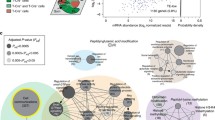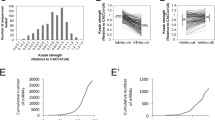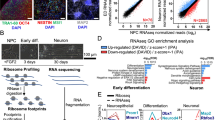Abstract
Translational repression is a key component of the mechanism that establishes segment polarity during early embryonic development in the fruitfly Drosophila melanogaster. Two proteins, Pumilio (Pum) and Nanos, block the translation of hunchback messenger RNA in only the posterior segments, thereby promoting an abdominal fate. More recent studies focusing on postembryonic neuronal function have shown that Pum is also integral to numerous mechanisms that allow neurons to adapt to the changing requirements placed on them in a dynamic nervous system. These mechanisms include those contributing to dendritic structure, synaptic growth, neuronal excitability, and formation of long-term memory. This article describes these new studies and highlights the role of translational repression in regulation of neuronal processes that compensate for change.
Similar content being viewed by others
References
Turrigiano G. G. and Nelson S. B. (2000) Hebb and homeostasis in neuronal plasticity. Curr. Opin. Neurobiol. 10, 358–364.
Ye B., Petritsch C., Clark I. E., Gavis E. R., Jan L. Y., and Jan Y. H. (2004) nanos and pumilio are essential for dendrite morphogenesis in Drosophila peripheral neurons. Curr. Biol. 14, 314–321.
Menon K. P., Sanyal S., Habara, Y., et al. (2004) The translational repressor Pumilio regulates presynaptic morphology and controls postsynaptic accumulation of translation factor eIF-4E. Neuron. 44, 663–676.
Mee C. J., Pym E. C. G., Moffat K. G., and Baines R. A. (2004) Regulation of neuronal excitability through pumilio-dependent control of a sodium channel gene. J. Neurosci. 24, 8695–8703.
Dubnau J., Chian A. S., Grady L., et al. (2003) The staufen/pumilio pathway is involved in Drosophila long-term memory. Curr. Biol. 13, 286–296.
Tautz D. (1988). Regulation of Drosophila segmentation gene hunchback by two maternal morphogenetic centres. Nature 332, 281–284.
Wharton R. P. and Struhl G. (1991) RNA regulatory elements mediate control of Drosophila body pattern by the posterior morphogen nanos. Cell 67, 955–967.
Wharton R. P., Sonoda J., Lee T., Patterson M., and Murata Y. (1998) The Pumilio RNA-binding domain is also a translational repressor. Mol. Cell 1, 863–872.
Zamore P. D., Williamson J. R., and Lehmann R. (1997) The Pumilio protein binds RNA through a conserved domain that defines a new class of RNA-binding proteins. RNA 3, 1421–1433.
Wreden C., Verotti A. C., Schisa J. A., Lieberfarb M. E., and Strickland S. (1997) Nanos and pumilio establish embryonic polarity in Drosophila by promoting posterior deadenylation of hunchback mRNA. Development 124, 3015–3023.
Sonoda J. and Wharton R. P. (1999) Recruitment of Nanos to hunchback mRNA by Pumilio. Genes Dev. 13, 2704–2712.
Sonoda J. and Wharton R. P. (2001) Drosophila Brain Tumor is a translational repressor. Genes Dev. 15, 762–773.
Chagnovich D. and Lehmann R. (2001) Poly(A)-independent regulation of maternal hunchback translation in the Drosophila embryo. Proc. Natl. Acad. Sci. USA 98, 11,359–11,364.
Dean K. A., Aggarwal A. K., and Wharton R. P. (2002) Translational repressors in Drosophila. Trends Neurosci. 18, 572–576.
Gavis E. R. (2001). Over the rainbow to translational control. Nat. Struct. Biol. 18, 387–389.
Parisi M. and Lin H. (2000) Translational repression: A duet of nanos and pumilio. Curr. Biol. 10, R81-R83.
Jan Y. H. and Jan L. Y. (2003) The control of dendrite development. Neuron 40, 229–242.
Wässle H. and Boycott B. B. (1991) Functional architecture of the mammalian retina. Physiol. Rev. 71, 447–478.
MacNeil M. A. and Masland R. H. (1998) Extreme diversity among amacrine cells: implications for function. Neuron 20, 971–982.
Sestan N., Artavanis-Tsakonas S., and Rakic P. (1999) Contact-dependent inhibition of cortical neurite growth mediated by notch signalling. Science 286, 741–746.
Logan M. A. and Vetter M. L. (2004) Do-it-yourself tiling: dendritic growth in the absence of homotypic contacts. Neuron 43, 439–446.
Steward O. and Schuman E. M. (2001) Protein synthesis at synaptic sites on dendrites. Annu. Rev. Neurosci. 24, 229–325.
Tang A. J. and Schuman E. M. (2000) Protein synthesis in the dendrite. Phil. Trans. R. Soc. Lond. B. 357, 521–529.
Grueber W. B., Ye B., Moore A. W., Jan L. Y., and Jan Y. N. (2003) Dendrites of distinct classes of Drosophila sensory neurons show different capacities for homotypic repulsion. Curr. Biol. 13, 618–626.
Knowles R. B., Sabry J. H., Martone M. E., et al. (1996) Translocation of RNA granules in living neurons. J. Neurosci. 16, 7812–7820.
Davis G. W. and Bezprozvanny I. (2001) Maintaining the stability of neural function: a homeostatic hypothesis. Annu. Rev. Physiol. 63, 847–869.
Davis G. W. and Goodman C. S. (1998) Synapse-specific control of synaptic efficacy at the terminals of a single neuron. Nature 392, 82–86.
Sigrist S. J., Thiel P. R., Reiff D. F., Lachance P. E., Lasko P., and Schuster C. M. (2000) Postsynaptic translation affects the efficacy and morphology of neuromuscular junctions. Nature 405, 1062–1065.
Sigrist S. J., Thiel P. R., Reiff D. F., and Schuster C. M. (2002) The postsynaptic glutamate receptor subunit DgluR-IIA mediates long-term plasticity in Drosophila. J. Neurosci. 22, 7362–7372.
Edwards T. A., Pyle S. E., Wharton R. P., and Aggarwal A. K. (2001) Structure of Pumilio reveals similarity between RNA and peptide binding motifs. Cell 105, 281–289.
Wang X., Zamore P. D., and Hall T. M. (2001) Crystal structure of a Pumilio homology domain. Mol. Cell 7, 855–865.
Desai N. S., Rutherford L. C., and Turrigiano G. G. (1999) Plasticity in the intrinsic excitability of cortical pyramidal neurons. Nat. Neurosci. 2, 515–520.
Baines R. A., Uhler J. P., Thompson A., Sweeney S. T., and Bate M. (2001) Altered electrical properties in Drosophila neurons developing without synaptic transmission. J. Neurosci. 21, 1523–1531.
Baines R. A. (2003) Postsynaptic protein kinase A reduces neuronal excitability in response to increased synaptic excitation in the Drosophila CNS. J. Neurosci. 23, 8664–8672.
Li M., West J. W., Lai Y., Scheuer T., and Catterall W. A. (1992) Functional modulation of brain sodium channels by cAMP-dependent phosphorylation. Neuron 8, 1151–1159.
Smith R. D. and Goldin A. L. (1997) Phosphorylation at a single site in the rat brain sodium channel is necessary and sufficient for current reduction by protein kinase A. J. Neurosci. 17, 6086–6093.
Catterall W. A. (2000) From ionic currents to molecular mechanisms: the structure and function of voltage-gated sodium channels. Neuron 26, 13–25.
Stern M., Blake N., Zondlo N., and Walters K. (1995) Increased neuronal excitability conferred by a mutation in the Drosophila bemused gene. J. Neurogenet. 10, 103–118.
Stern M. and Ganetzky B. (1989) Altered synaptic transmission in Drosophila hyperkinetic mutants. J. Neurogenet. 5, 215–228.
Stern M., Kreber R., and Ganetzky B. (1990) Dosage effects of a Drosophila sodium channel gene on behavior and axonal excitability. Genetics 124, 133–143.
Schweers B. A., Walters K. J., and Stern M. (2002) The Drosophila melanogaster translational repressor pumilio regulates neuronal excitability. Genetics 161, 1177–1185.
Barker D. D., Wang C., Moore J., Dickinson L. K., and Lehmann R. (1992) Pumilio is essential for function but not for distribution of the Drosophila abdominal determinant Nanos. Genes Dev. 6, 2312–2326.
Macdonald P. M. (1992) The Drosophila pumilio gene: an unusually long transcription unit and an unusual protein. Development 114, 221–232.
Zhang B., Gallegos M., Puoti A., et al. (1997) A conserved RNA-binding protein that regulates sexual fates in the C. elegans hermaphrodite germ line. Nature 390, 477–484.
Spassov D. S. and Jurecic R. (2002) Cloning and comparative sequence analysis of PUM1 and PUM2 genes, human members of the Pumilio family of RNA-binding proteins. Gene 299, 195–204.
Spassov D. S. and Jurecic R. (2003) MousePum1 and Pum2 genes, members of the Pumilio family of proteins, show differential expression in fetal and adult hematopoietic stem cells and progenitors. Blood Cells Mol. Dis. 30, 55–69.
White E. K., Moore-Jarrett T., and Ruley H. E. (2001) PUM2, a novel murine puf protein, and its consensus RNA-binding site. RNA 12, 1855–1866.
Jaruzelska J., Kotecki M., Kusz K., Spik A., Firpo M., and Reijo Pera R. A. (2003) Conservation of a Pumilio-Nanos complex from Drosophila germ plasm to human germ cells. Dev. Genes Evol. 213, 120–126.
Haraguchi S., Tsuda M., Kitajima S., et al. (2003) nanos1: a mouse nanos gene expressed in the central nervous system is dispensable for normal development. Mech. Dev. 120, 721–731.
Tsuda M., Sasaoka Y., Kiso M., et al. (2003) Conserved role of nanos proteins in germ cell development. Science 301, 1239–1241.
Lipshitz H. D. and Smibert C. A. (2000) Mechanisms of RNA localization and translational regulation. Curr. Opin. Gen. Dev. 10, 476–488.
Steward O. and Schuman E. M. (2003) Compartmentalized synthesis and degradation of protein in neurons. Neuron 40, 347–359.
Miller S., Yasuda M., Coats J. K., Jones Y., Martone M. E., and Mayford M. (2002) Disruption of dendritic translation of CaMKIIalpha impairs stabilization of synaptic plasticity and memory consolidation. Neuron 36, 507–519.
Kiebler M. A. and DesGroseillers L. (2000) Molecular insights into mRNA transport and local translation in the mammalian nervous system. Neuron 25, 19–28.
Author information
Authors and Affiliations
Corresponding author
Rights and permissions
About this article
Cite this article
Baines, R.A. Neuronal homeostasis through translational control. Mol Neurobiol 32, 113–121 (2005). https://doi.org/10.1385/MN:32:2:113
Received:
Accepted:
Issue Date:
DOI: https://doi.org/10.1385/MN:32:2:113




